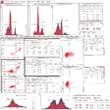
Methods of Investigation
for FP7 partners
and coordinators
|
|||
| Home | |||
| Cytotechnology Group | |||
| Staff | |||
| Methods | |||
| Projects | |||
| Research Results | |||
| Patents | |||
| Image Gallery | |||
| Cooperation | |||
| Contact Us | |||
Recombinant AAV Vectors for Long-Term CD59 Expression in Transgenic Islet Cells |
|
Workshop "Programming Pancreatic beta-Cells". El Perello, Spain (October 18-22, 2006) RECOMBINANT AAV VECTORS FOR LONG-TERM CD59 EXPRESSION IN TRANSGENIC ISLET CELLS In modern biomedicine the role of cell culture conditioning and analysis is increasing steadily due to its active use for artificial organs and grafting. One of such approaches is xenotransplantation, including animal-to-human transplantation of pancreatic islet cells, where the graft rejection is the major problem. Immune response, of which complement system takes essential part, leads to noticeable reduction in graft survival. Researchers therefore seek to prevent foreign graft destruction, and methods offered by molecular biology seem promising in many cases. In particular, transgenic expression of factors like a-Gal-epitope, IL-1 receptor antagonist, CTLA4g, IL-4 and IL-10 cytokines, antioxidants like heme-oxygenase-1, apoptosis inhibitors like Bcl-2 and others, proved effective for either long- or short-term graft protection. Another candidate gene to reduce immune system-induced damage is CD59. In design of molecular complement protection system, CD59 (MIRL, membrane inhibitor of reactive lysis) is a gene of choice as it interacts with complement at terminal stage of complex formation. It could be especially useful if combined with agarose hydrogel or alginate encapsulated cell grafting, which is currently practiced in our laboratory. We isolated CD59 sequence from human liver cDNA by PCR, verified by sequencing after subcloning to p Bluescript and inserted into AAV expression vector (Stratagene) at ClaI and BglII sites under CMV promoter. AAV vector proved effective in stable and long-term transgene expression in a number of mammalian hosts without undesirable side effects. We also created vector for combined expression of CD59 and IRES-GFP cassette in order to monitor transgene expression, as well as population enrichment with CD59 expressing cells, by inserting our gene of interest at SacI and HincII sites of pAAV-IRES-hrGFP vector. All molecular cloning procedures were performed using Fermentas and NEB enzymes, and verified using endonuclease digestion and PCR. Vectors were introduced into HEK 293 cells using various transfection protocols (with calcium chloride, EscortII (Sigma) or Exgen500 (Fermentas) reagent) together with helper plasmids carrying rep and cap AAV genes, as well as adenovirus genes required by AAV to action. CMV promoter-driven expression was monitored using fluorescence microscopy for GFP (for pAAV-CD59-IRES-hrGFP construct) and immunofluorescence staining for CD59 (for pAAV-CD59 construct). At present we study the ways to improve the efficiency of primary islet cell transduction under various conditions, as well as the grade of CD59 mediated cell protection. Lentivirus-mediated transfer protocols are also being optimized using FELIX vector system.
|
| COOPERATION NEWS | ||
FP7 Programme involves subjects
|
||
| CURRENT RESEARCH | ||
|
||
| 2005-2007 © LBMI |



